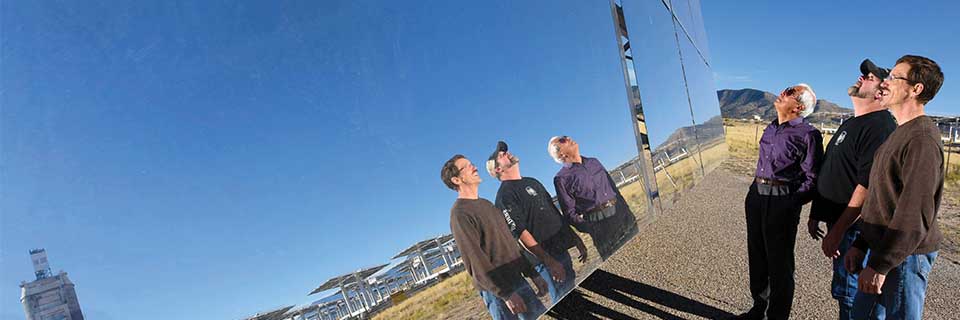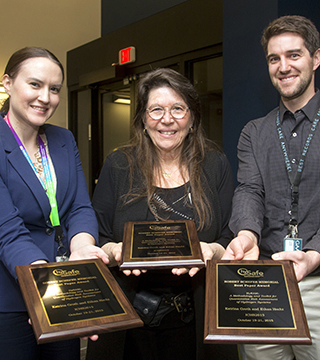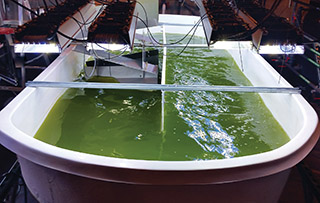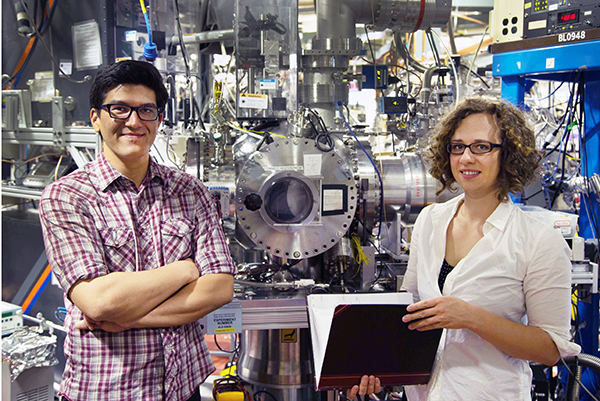
Sandia’s National Solar Thermal Test Facility (NSTTF) was used for extensive baseline performance testing of heliostat prototypes by the renewable energy company SolarReserve. The company is developing advanced heliostat designs and control algorithms to increase the efficiencies of its solar power systems, which are deployed around the world. SolarReserve chose the NSTTF because of Sandia’s “knowledge and reputation in the solar industry, as well as the breadth of resources available for improving and testing new designs.” The testing at Sandia led to important component modifications. (6100) EC, SSEF

Katrina Groth, left, and Ethan Hecht are shown with Jade Schefer, wife of the late Robert Schefer, the researcher for whom the award is named.
Sandia engineers Katrina Groth and Ethan Hecht won the Robert Schefer Best Paper award, presented at the 2015 IA-HySafe International Conference on Hydrogen Safety. Their paper, chosen from 167 submissions to the conference, describes the Hydrogen Risk Assessment Model (HyRAM), a toolkit for modeling the safety of hydrogen storage and fueling systems. The toolkit will aid the hydrogen codes and standards community as it develops models of hydrogen releases to support deployment of hydrogen refueling infrastructure and hydrogen fuel cell technologies. (6200, 8300) EC, SSEF
The Sandia Wake Imaging System is a prototype Global Doppler Velocimeter designed to measure large scale inflow and outflow wind patterns associated with wind turbines. When fully implemented, this measurement type will be the first of its kind and will lead to improved predictive wind farm flow patterns. The results from this work will lead to improved turbine and wind farm designs to achieve higher energy efficiency rates. (1100, 6100, 5700) EC, SSEF
A very high-precision, high-power machine to test batteries was developed with external partners Ford and Arbin. It delivers 200 amps with precision six times better than previous testers. The machine was developed as a tool to allow researchers to better predict the life of a rechargeable battery. This is crucial for electric vehicle or stationary storage batteries that must last a decade or longer. The objective is to use high-precision measures during early performance to extrapolated behavior over the life of these batteries. (2500) EC, SSEF

Algal testbed designed to understand and mitigate pathogens and predators that can “crash” algae cultures.
Sandia has implemented an algal testbed research facility designed to understand and mitigate pathogens and predators that can “crash” algae cultures, a critical barrier to commercializing algae biofuels. Unique to this facility are advanced hyperspectral monitoring and metagenomic diagnostics developed at Sandia that provide real-time cell density and health of the algae. When completed, the temperature and lighting can be controlled to simulate different geographic locations and environmental conditions. The three 1,000-liter raceways are geometrically similar to commercial units for scale-up from lab to field. EC, SSEF
Sandia has formed an industry-funded Spray Combustion Consortium to build on the foundational scientific knowledge generated under DOE-funded projects and develop validated, predictive tools enabling the design of advanced direct-injection engines. The consortium is a partnership among Sandia, Argonne National Laboratory, the University of Massachusetts, vehicle and engine manufacturers, and commercial computational fluid dynamics software vendors. To date, six industry partners have signed on to support this effort at a level of $100,000/partner/year, and negotiations are continuing with several others. The three-year project began Nov. 10. (8300) EC, SSEF
A breakthrough to cleaner engines

Sandia researchers are the first ever to directly measure a “QOOH” radical, a key reactive step in the chain of reactions in hydrocarbon oxidation. Because QOOH reactions help determine both ignition chemistry and the production of organic particulates, the QOOH reaction rates and outcomes from this breakthrough can increase the fidelity of models used to create cleaner and more efficient cars and trucks, and improve the description of oxidation processes that can lead to aerosol haze in Earth’s atmosphere. (8300) EC SSEF